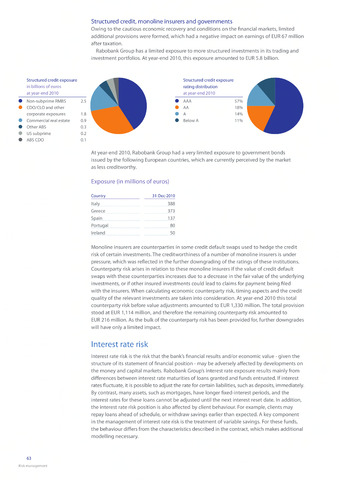Interest rate risk
Structured credit, monoline insurers and governments
Owing to the cautious economic recovery and conditions on the financial markets, limited
additional provisions were formed, which had a negative impact on earnings of EUR 67 million
after taxation.
Rabobank Group has a limited exposure to more structured investments in its trading and
investment portfolios. At year-end 2010, this exposure amounted to EUR 5.8 billion.
Structured credit expos
in billions of euros
at year-end 2010
Non-subprime RMBS
CDO/CLO and other
corporate exposures
Commercial real estate
Other ABS
US subprime
ABS CDO
At year-end 2010, Rabobank Group had a very limited exposure to government bonds
issued by the following European countries, which are currently perceived by the market
as less creditworthy.
Exposure (in millions of euros)
Country 31-Dec-2010
Italy 388
Greece 373
Spain 137
Portugal 80
Ireland 50
Monoline insurers are counterparties in some credit default swaps used to hedge the credit
risk of certain investments. The creditworthiness of a number of monoline insurers is under
pressure, which was reflected in the further downgrading of the ratings of these institutions.
Counterparty risk arises in relation to these monoline insurers if the value of credit default
swaps with these counterparties increases due to a decrease in the fair value of the underlying
investments, or if other insured investments could lead to claims for payment being filed
with the insurers. When calculating economic counterparty risk, timing aspects and the credit
quality of the relevant investments are taken into consideration. At year-end 2010 this total
counterparty risk before value adjustments amounted to EUR 1,330 million. The total provision
stood at EUR 1,114 million, and therefore the remaining counterparty risk amounted to
EUR 216 million. As the bulk of the counterparty risk has been provided for, further downgrades
will have only a limited impact.
Interest rate risk is the risk that the bank's financial results and/or economic value - given the
structure of its statement of financial position - may be adversely affected by developments on
the money and capital markets. Rabobank Group's interest rate exposure results mainly from
differences between interest rate maturities of loans granted and funds entrusted. If interest
rates fluctuate, it is possible to adjust the rate for certain liabilities, such as deposits, immediately.
By contrast, many assets, such as mortgages, have longer fixed-interest periods, and the
interest rates for these loans cannot be adjusted until the next interest reset date. In addition,
the interest rate risk position is also affected by client behaviour. For example, clients may
repay loans ahead of schedule, or withdraw savings earlier than expected. A key component
in the management of interest rate risk is the treatment of variable savings. For these funds,
the behaviour differs from the characteristics described in the contract, which makes additional
modelling necessary.
Structured credit exposure
rating distribution
at year-end 2010
AAA
AA
A
Below A
63
Risk management

